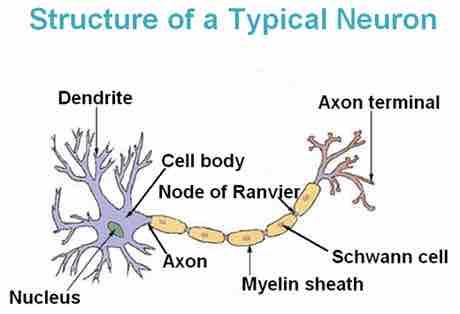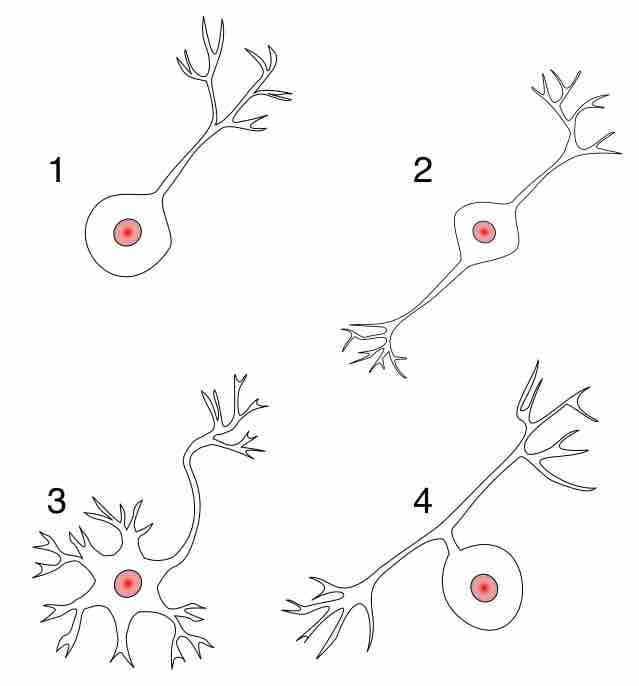The neuron is the basic building block of the brain and central nervous system. Neurons are specialized cells that transmit chemical and electrical signals. The brain is made up entirely of neurons and glial cells, which are non-neuronal cells that provide structure and support for the neurons. Nearly 86 billion neurons work together within the nervous system to communicate with the rest of the body. They are responsible for everything from consciousness and thought to pain and hunger. There are three primary types of neuron: sensory neurons, motor neurons, and interneurons.
Structures of a Neuron
In addition to having all the normal components of a cell (nucleus, organelles, etc.) neurons also contain unique structures for receiving and sending the electrical signals that make neuronal communication possible.

The structure of a neuron
The above image shows the basic structural components of an average neuron, including the dendrite, cell body, nucleus, Node of Ranvier, myelin sheath, Schwann cell, and axon terminal.
Dendrite
Dendrites are branch-like structures extending away from the cell body, and their job is to receive messages from other neurons and allow those messages to travel to the cell body. Although some neurons do not have any dendrites, other types of neurons have multiple dendrites. Dendrites can have small protrusions called dendritic spines, which further increase surface area for possible connections with other neurons.
Cell Body
Like other cells, each neuron has a cell body (or soma) that contains a nucleus, smooth and rough endoplasmic reticulum, Golgi apparatus, mitochondria, and other cellular components.
Axon
An axon, at its most basic, is a tube-like structure that carries an electrical impulse from the cell body (or from another cell's dendrites) to the structures at opposite end of the neuron—axon terminals, which can then pass the impulse to another neuron. The cell body contains a specialized structure, the axon hillock, which serves as a junction between the cell body and the axon.
Synapse
The synapse is the chemical junction between the axon terminals of one neuron and the dendrites of the next. It is a gap where specialized chemical interactions can occur, rather than an actual structure.
Function of a Neuron
The specialized structure and organization of neurons allows them to transmit signals in the form of electric impulses from the brain to the body and back. Individually, neurons can pass a signal all the way from their own dendrites to their own axon terminals; but at a higher level neurons are organized in long chains, allowing them to pass signals very quickly from one to the other. One neuron's axon will connect chemically to another neuron's dendrite at the synapse between them. Electrically charged chemicals flow from the first neuron's axon to the second neuron's dendrite, and that signal will then flow from the second neuron's dendrite, down its axon, across a synapse, into a third neuron's dendrites, and so on.
This is the basic chain of neural signal transmission, which is how the brain sends signals to the muscles to make them move, and how sensory organs send signals to the brain. It is important that these signals can happen quickly, and they do. Think of how fast you drop a hot potato—before you even realize it is hot. This is because the sense organ (in this case, the skin) sends the signal "This is hot!" to neurons with very long axons that travel up the spine to the brain. If this didn't happen quickly, people would burn themselves.
Other Structures
Dendrites, cell bodies, axons, and synapses are the basic parts of a neuron, but other important structures and materials surround neurons to make them more efficient.
Myelin Sheath
Some axons are covered with myelin, a fatty material that wraps around the axon to form the myelin sheath. This external coating functions as insulation to minimize dissipation of the electrical signal as it travels down the axon. Myelin's presence on the axon greatly increases the speed of conduction of the electrical signal, because the fat prevents any electricity from leaking out. This insulation is important, as the axon from a human motor neuron can be as long as a meter—from the base of the spine to the toes. Periodic gaps in the myelin sheath are called nodes of Ranvier. At these nodes, the signal is "recharged" as it travels along the axon.
Glial Cells
The myelin sheath is not actually part of the neuron. Myelin is produced by glial cells (or simply glia, or "glue" in Greek), which are non-neuronal cells that provide support for the nervous system. Glia function to hold neurons in place (hence their Greek name), supply them with nutrients, provide insulation, and remove pathogens and dead neurons. In the central nervous system, the glial cells that form the myelin sheath are called oligodendrocytes; in the peripheral nervous system, they are called Schwann cells.
Neuron in the central nervous system
This neuron diagram also shows the oligodendrocyte, myelin sheath, and nodes of Ranvier.
Types of Neurons
There are three major types of neurons: sensory neurons, motor neurons, and interneurons. All three have different functions, but the brain needs all of them to communicate effectively with the rest of the body (and vice versa).
Sensory Neurons
Sensory neurons are neurons responsible for converting external stimuli from the environment into corresponding internal stimuli. They are activated by sensory input, and send projections to other elements of the nervous system, ultimately conveying sensory information to the brain or spinal cord. Unlike the motor neurons of the central nervous system (CNS), whose inputs come from other neurons, sensory neurons are activated by physical modalities (such as visible light, sound, heat, physical contact, etc.) or by chemical signals (such as smell and taste).
Most sensory neurons are pseudounipolar, meaning they have an axon that branches into two extensions—one connected to dendrites that receive sensory information and another that transmits this information to the spinal cord.

Multipolar and pseudounipolar neurons
This diagram shows the difference between: 1) a unipolar neuron; 2) a bipolar neuron; 3) a multipolar neuron; 4) a pseudounipolar neuron.
Motor Neurons
Motor neurons are neurons located in the central nervous system, and they project their axons outside of the CNS to directly or indirectly control muscles. The interface between a motor neuron and muscle fiber is a specialized synapse called the neuromuscular junction. The structure of motor neurons is multipolar, meaning each cell contains a single axon and multiple dendrites. This is the most common type of neuron.
Interneurons
Interneurons are neither sensory nor motor; rather, they act as the "middle men" that form connections between the other two types. Located in the CNS, they operate locally, meaning their axons connect only with nearby sensory or motor neurons. Interneurons can save time and therefore prevent injury by sending messages to the spinal cord and back instead of all the way to the brain. Like motor neurons, they are multipolar in structure.